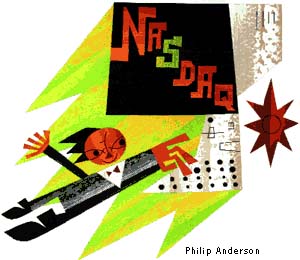
On October 28, 1997, when trading volume on the Nasdaq Stock Market soared to a record high of 1.35 billion shares, there were 20 million hits on its Web site. Alfred Berkeley III, WG’68, loves such statistics, because they illustrate his efforts to open up the market to as many players as possible. “Our structure and our goal,” he says, “is identical to the structure of the World Wide Web: The more people playing, the stronger it gets. We’re very keen on continuing to make the market accessible for individuals and institutions, making the playing field level for them and getting costs down by investing in technology.”
Nasdaq, which uses computers and telecommunications in place of a trading floor, hasn’t always had that accessible image. Before Berkeley was tapped for the role of president in June 1996, the market’s parent organization, the National Association of Securities Dealers, Inc., was censured by the Securities and Exchange Commission for failing to police dealers who colluded to inflate trading costs. This practice particularly hurt small investors.
But since the reforms, dealer spreads — their profits on trades between buy and sell orders — have dropped by 26 percent. “We actually think we have pricing parity and liquidity superiority to any other market in the world now,” Berkeley says. A proposed merger of Nasdaq, the nation’s second-largest stock market, and the American Stock Exchange, the nation’s third-largest market — announced by the NASD at press time — should heighten competition with the world’s largest market, the New York Stock Exchange.
Berkeley, a former U.S. Air Force captain, spent most of his career at the Baltimore investment firm of Alex Brown & Sons before arriving at Nasdaq. It is a career move that he never could have predicted, especially because construction of Nasdaq — the world’s first electronic-based stock market — was just starting when he graduated from Wharton. “I didn’t have any of this kind of career planning stuff that MBA students today talk about all the time,” he says. “I felt I was lucky to get a job.”
His goal is to make Nasdaq “a market of markets built on a network of networks.” One way he hopes to accomplish this is by inundating investors around the world with information. Nasdaq’s data-packed Web site includes links to listed companies, market news, stock quotes, and a portfolio-tracking feature. Nasdaq will spend up to $600 million to upgrade its communications network, giving it the capacity to handle trades of up to eight billion shares a day. It is also negotiating with OptiMark Technologies, Inc. to use supercomputing to match customers’ orders. Instead of entering orders at only one price and size, investors could indicate a range that would satisfy them and get the best available deal.




